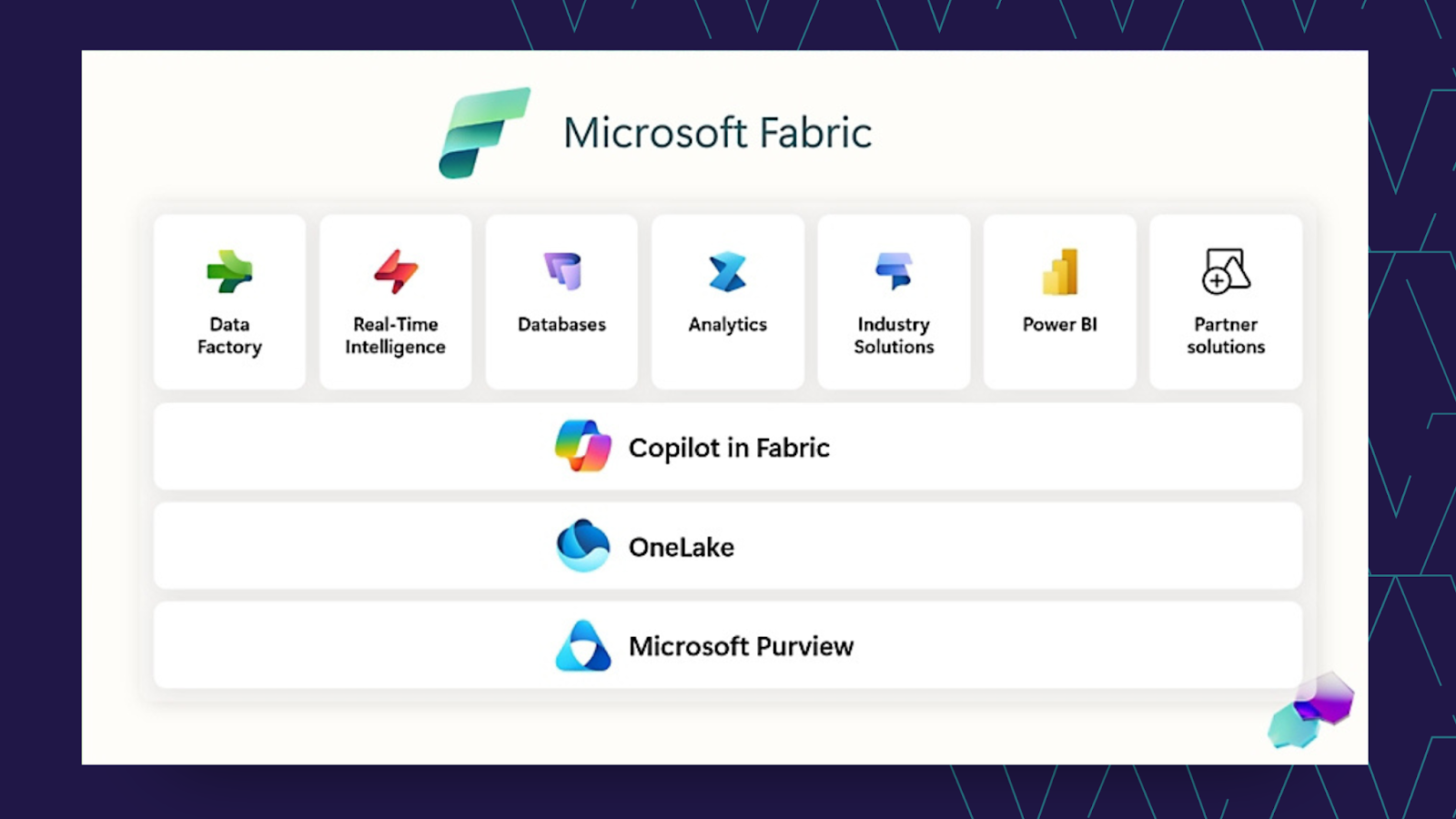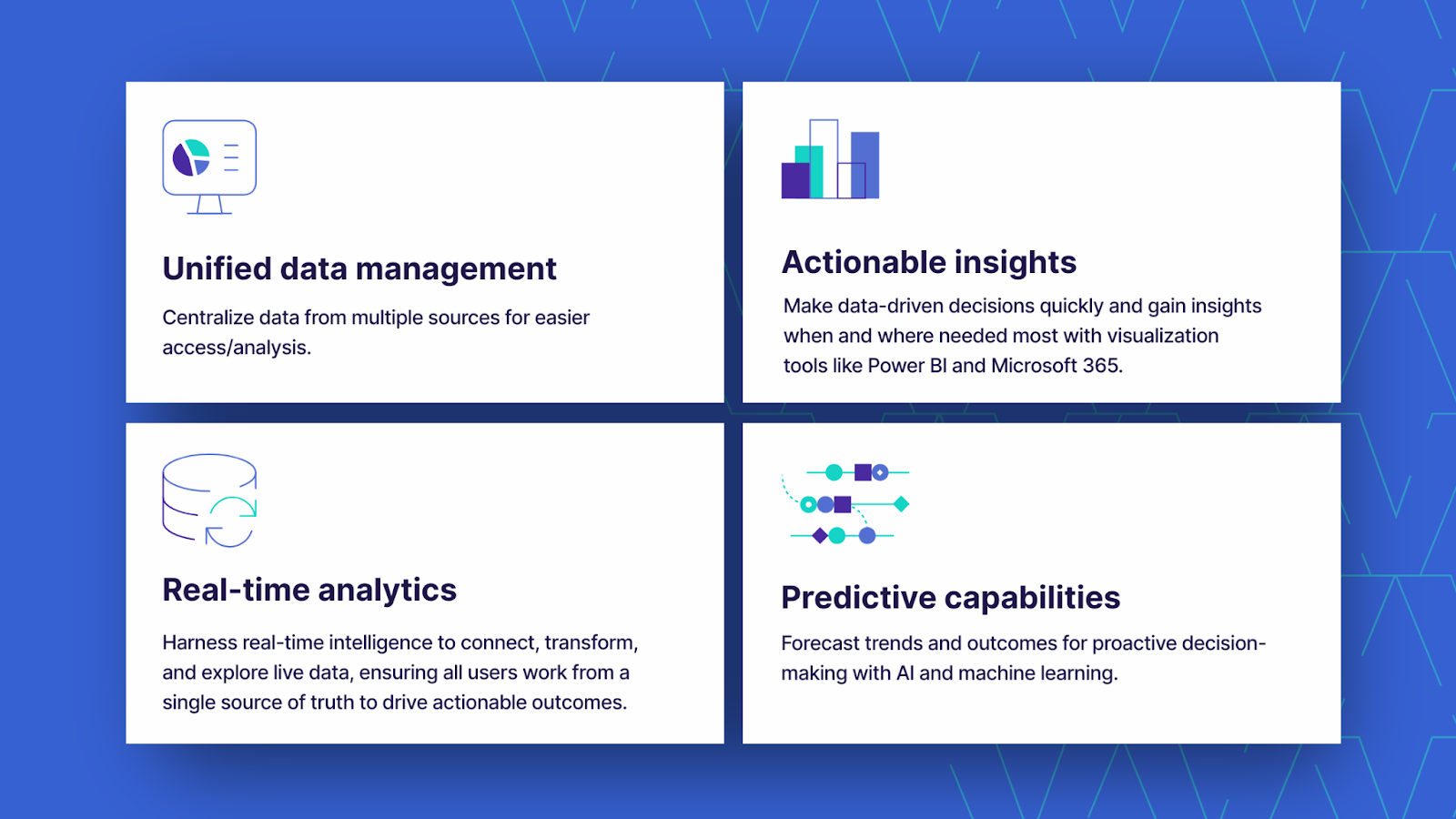Home / Blog / Insights / What Is Microsoft Fabric—And Why Are We So Excited About It?

What Is Microsoft Fabric—And Why Are We So Excited About It?
Data has never been more abundant or more frustrating. You’ve got spreadsheets, reports, BI tools, data lakes, and warehouses scattered across departments. But instead of faster answers, you’re left with silos, duplicated work, manual processes, and a growing stack of tools that don’t quite fit together.
It’s no surprise that organizations are investing heavily to change that. The global data governance market was valued at $4.44 billion in 2024 and is projected to reach $18.07 billion by 2032, growing at nearly 19% annually. But while investment is climbing, results are not. According to Forrester, fewer than 10% of enterprises are advanced in their insights-driven capabilities.
That disconnect—between the potential of data and the reality of accessing and trusting it—is exactly the challenge Microsoft set out to solve with Fabric. Whether you’re wrangling messy reporting pipelines, dealing with fragmented governance, or just tired of exporting data between tools, Microsoft Fabric offers a new way forward.
In this article, we’ll explore:
- What is Microsoft Fabric?
- What makes Fabric different?
- How Convverge is using Fabric today
- Microsoft Fabric use cases and outcomes
- Is Microsoft Fabric right for you?
Let’s get into it.
What Is Microsoft Fabric?
Microsoft Fabric is an end-to-end analytics platform built to simplify your data ecosystem. Rather than relying on a patchwork of disconnected tools for storing, processing, analyzing, and visualizing data, Fabric brings everything together in one integrated SaaS solution.
Fabric unifies familiar Microsoft tools like:
- Power BI for business intelligence
- Azure Synapse for data warehousing and analytics
- Data Factory for data movement and transformation
- OneLake as a centralized, lake-first storage foundation
Think of it as the connective tissue that ties your data workflows together, from ingestion to insight, within the Microsoft environment you’re already using.
Fabric is designed for both IT teams and business users. That means advanced functionality like Eventstreaming and real-time analytics paired with user-friendly features like Copilot-powered queries and low-code reporting. It’s built for scale, but keeps it simple.
While Power BI is focused on data visualization and reporting, Microsoft Fabric goes deeper. It includes Power BI as one component of a full analytics platform that also covers data movement, transformation, storage, and governance. Think of Power BI as the front-end dashboard and Fabric as the entire ecosystem behind it.
What Makes Fabric Different?
Plenty of businesses already use tools like Power BI, data warehouses, or Azure Synapse. So what makes Microsoft Fabric worth paying attention to? The difference lies in how everything works together.
Traditionally, organizations have cobbled together a mix of platforms for ETL (extract, transform, load), data storage, analytics, and governance. Each tool has its own setup, security, user interface, and maintenance requirements. And while integrations exist, they’re often prone to issues like breakage, duplication, and lag.
Fabric takes a fundamentally different approach by unifying the full data stack into one seamless platform. That means:
- OneLake provides a single, centralized location for data storage
- Power BI, Synapse, and Data Factory are natively integrated
- Governance, security, and access control are consistent across the board
- Users can collaborate through Microsoft 365 tools like Teams and Excel
- Copilot AI is embedded throughout to make complex tasks easier
Instead of stitching together separate solutions, Fabric gives you a consistent, modular architecture that’s easier to manage and far more efficient.
As Patricia Harty, Convverge’s Team Lead of Data & Analytics, puts it:
I find Fabric a lot easier to maintain. Everything is divided out into modules, but all the modules talk to each other seamlessly. Versus if you’re using a patchwork of different tools, a big worry is the integration between those tools. Those are major points of failure which don’t occur with Fabric since they’re all natively talking to each other.
The result? Less time spent managing tools, more confidence in your data, and faster paths to real business insights.

How We’re Using Fabric Today
At Convverge, we’ve already seen how Microsoft Fabric can transform complex data environments… and we’re using it to help our clients do just that.
Take a recent project with a mid-sized industrial manufacturing company. They were facing a familiar set of challenges:
- Multiple subsidiaries using different systems
- Siloed data that couldn’t be easily shared or compared
- Reporting delays due to having to manually track down data
- No central method to verify data accuracy or trace its origin
These challenges lead to fragmented information, inefficient processes, and impaired decision-making.
To solve this, we partnered with their team to design and implement a centralized data warehouse built on Microsoft Fabric. We began with a discovery phase to understand their current data landscape and define a clear path forward. From there, we implemented a modern data solution that included:
- An Azure Data Lake to store and organize data from all subsidiaries
- Fabric Pipelines and Notebooks to automate daily transformation and loading
- A Fabric Warehouse to serve as an enterprise data warehouse, bringing together clean, structured data for cross-company reporting and analytics
- Power BI dashboards to make reporting clear, consistent, and accessible
- A Master Data Management (MDM) application that non-technical users could benefit from
The impact was significant:
- 95% reduction in report preparation time
- Greater operational efficiency across departments
- Improved data availability and accessibility
- High confidence in data accuracy and traceability
- Self-service reporting enabled for business users
This is just one example of how Fabric can help organizations modernize their data strategy without needing to replace what already works.
A data lake stores raw, unstructured data from multiple sources, while a data warehouse organizes that data into structured formats for analysis. With Microsoft Fabric, you don’t have to choose. OneLake acts as a unified data lake, and you can create Fabric Warehouses on top of it for structured reporting. It’s the best of both worlds, built into one platform.
What’s In It for You: Use Cases and Outcomes
Whether you’re in finance, operations, or IT, Fabric enables faster, more confident decisions by making data easier to access, analyze, and act on. Here are some practical use cases where we’ve seen the biggest impact:
Forecasting and business planning
Fabric supports near real-time data ingestion and modeling, so you can base forecasts on up-to-date information rather than outdated spreadsheets.
Operational reporting
With eventstreaming and eventhousing capabilities, Fabric can surface critical operational insights as they happen rather than hours or days later. Put simply, eventstreaming allows data to be captured in real time as it’s generated, while eventhousing stores and organizes those events for instant access and analysis.
Self-service dashboards for non-technical users
Business users no longer need to wait on IT. Copilot is embedded into Fabric, allowing users to ask natural-language questions about their data, generate reports, or even build data pipelines with guidance from AI.
Automated data refresh pipelines
Fabric helps eliminate manual refresh processes by enabling automated pipelines. No custom code or third-party tools required.
In short, Fabric reduces the distance between raw data and real insight. Whether you’re trying to align departments, improve data trust, or empower more people to work with data, Fabric helps you get there faster.
Is Microsoft Fabric Right for You?
As with any new technology, Microsoft Fabric isn’t a one-size-fits-all solution. But for many organizations, it’s a smart next step. Here are a few questions to help you assess whether Fabric could be a fit for your business:
- Are you already using Microsoft 365, Azure, or Power BI?
- Are your data sources disconnected or difficult to manage?
- Do you spend more time preparing reports than analyzing them?
- Are you struggling with inconsistent governance or data trust?
- Do you want to enable self-service reporting without adding complexity?
- Are you looking for ways to support AI and automation down the road?
If you answered YES to more than one of the above, Fabric is worth exploring. While it’s still a relatively new offering, adoption is ramping up quickly. Even if you’re not ready for a full migration, Fabric’s modular design allows for phased implementation. You can start small and grow over time as your needs evolve.

Data Curious? Let’s Talk
At Convverge, we help organizations take the guesswork out of data strategy, and Microsoft Fabric is one of the most exciting tools we’ve seen in years.
Whether you’re just starting to explore your options or already envisioning a new architecture, we can guide you through every step: from assessing your current data environment to building a roadmap, implementing Fabric, and creating intuitive, impactful dashboards your team will actually use.
Want to see what Fabric could look like in your organization? Let’s talk. Book a discovery session today.


